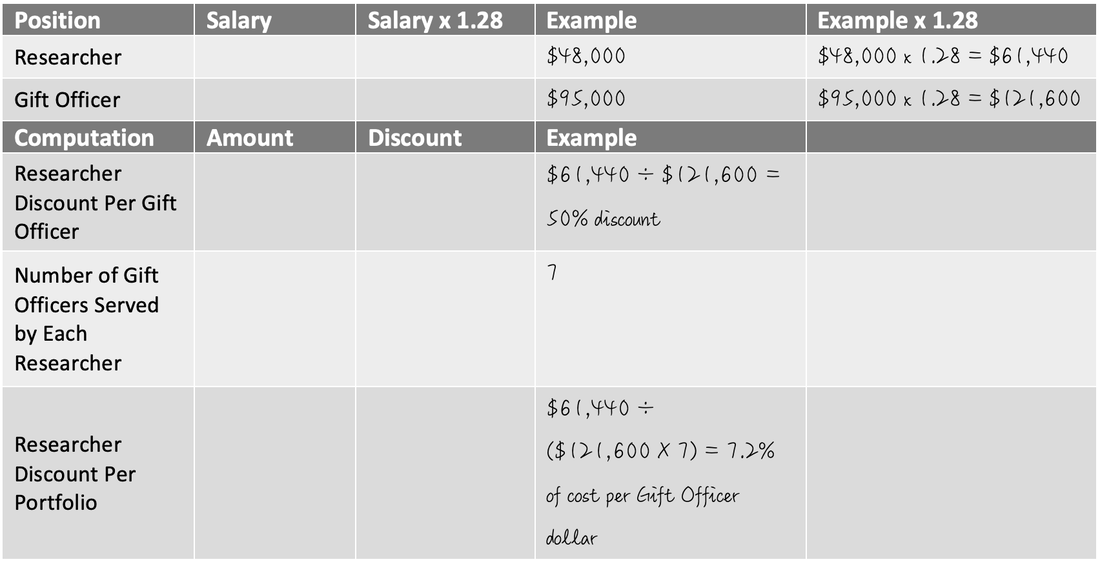|
With Worksheets and Suggestions for Cost Cutting that Will Better Support Fundraising  During the 2008 economic crash, my employer had to lay of 10% of the Advancement Office. We just had to. I had to choose to lay people off. It was miserable. What it taught me, though, is that management is just as confused and frustrated as staff are when it comes to figuring out what budgets and whose jobs to cut. Of course, we are going to advocate for leaving Prospect Research intact because that is where we come from. However, you can back up these assertions for your own shop by using data. Let’s begin. The temptation will be to take all the cuts from any staff who are not frontline staff. The logic goes like this: We need major gift officers to keep raising major gifts, so we’ll keep them and lay off other people; oh, and we need gift processors, so we’ll keep them. With this logic, everyone else’s job is at risk. It’s tempting, isn’t it? And it’s an easy decision to make. Let’s look at the effect of cutting Research, Stewardship, and Annual Giving:
Now you have some information about the impact of Prospect Research on the efficiency of your gift officer team. Using our example, we would assert that no Research team means that the gift officers would be bringing in major gifts from less than 1% of their portfolios if left on their own to prospect, whereas the Research team’s work increased that efficiency by 18,500%. Or, put the opposite way, if gift officers had to randomly pick prospects from the entire constituency, then they would use up (185) times the resources used when the Research team is involved. “Yeah, but,” you may say, “the gift officers would be choosier than that.” We agree – the MG team may not choose prospects from as random a pool as the entire constituency. But here is where we at Staupell assert that they would most likely do worse. When consulting with fundraising offices, we hear that gift officers use tried and failed paradigms to identify new prospects, such as giving history and constituents who own land in fracking zones. They do not have the skills to slice out the top-level capacity from a constituency and then to assess liquidity and readiness. It’s like an oil company telling its drillers to just keep drilling until they hit oil because the company couldn’t afford the geologists anymore. Gift officers should not have to do their own prospecting. Let’s look at it another way. Doctors have nurses to provide care at a cheaper pay rate, though the services are charged to the insurance company at full price. Then LPNs came on the scene to do more rudimentary nursing tasks because they cost less per hour, but the bill rate to the insurance company remains the same. Then hospitals started hiring people to do one job, like taking blood, so they could pay these people at the technician rate. If we told our doctors to do it all themselves, they’d see fewer than half of the patients in a day that they see now. So, let’s do our next worksheet.
Now you can show both the impact of your work and the minimal cost that is really involved. (You can also get mad about the disparity in your paychecks, but that’s for another time.)
“Yeah, but,” you may say, “we still have to cut costs.” Yes, you do. This forced economic recession that we’re in pretty much puts industry and commerce at just above a standstill. Like it or not, something has to go. Here is our list of suggestions for cost cutting, even suggestions for changes that allow for staff reductions (because some nonprofits will insist on those systemwide). Automate absolutely everything you can
Write a plan to reduce the number of Major Gifts prospects to those who are most likely to give (this set of suggestions can only be implemented by management, but they may appreciate the ideas)
Re-think Your Administrative Staff
I wrote this blog post to give you hope that you have something else to do besides sit by and wait to be laid off. Change you initiate is easier for you to swallow, and you can initiate change by offering plans that get the work done but cut costs. We want you to remain employed because we love being with you. If you have comments (including how your organization is handling the crisis), share them with me at [email protected].
0 Comments
Leave a Reply. |
Keep Informed
|
Photos from jeffdjevdet, SMPAGWU




